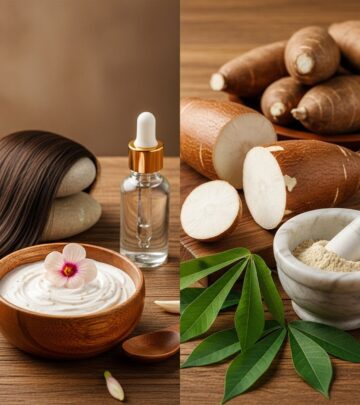Triolein: Uses, Benefits, and Safety in Cosmetics
Explore the cosmetic science, benefits, and safety of Triolein—a plant-derived triglyceride valued for moisturizing and formulation versatility.

What is Triolein?
Triolein is a naturally occurring triglyceride formed by esterifying glycerol with three units of oleic acid. Recognized by its International Nomenclature Cosmetic Ingredient (INCI) name, it is a clear, pale yellow viscous liquid, notable for its high stability and non-drying characteristics. Triolein constitutes a significant portion (up to 80%) of olive oil, and is also found in almond oil and other plant-based oils.
In cosmetics, Triolein is classified among Glyceryl Triesters, along with other similar compounds such as trilaurin, tribehenin, and tristearin. These ingredients occur naturally in vegetable oils and fats, and Triolein is often derived and purified for use through controlled esterification processes.
Chemical Structure
- Chemical Name: 1,2,3-Propanetriyl trioleate.
- Molecular Formula: C57H104O6
- Composition: Glycerol backbone esterified with three oleic acid molecules.
Physical Properties
- Appearance: Clear, pale yellow viscous liquid
- State: Liquid at room temperature
- Source: Extracted from oils rich in oleic acid, e.g., olive oil, almond oil
Why is Triolein Used in Cosmetics?
Triolein offers multiple functional benefits that have led to its widespread use in cosmetic formulations. It serves as a skin conditioning agent, viscosity control agent, and in some products, acts as a hair conditioning agent.
Main Functions of Triolein in Cosmetics
- Emollient/Skin Conditioning Agent: Softens, hydrates, and smooths the skin by forming an occlusive film that reduces water loss.
- Viscosity Controlling Agent: Influences the thickness and spreadability of creams and lotions, ensuring a consistent, pleasant texture.
- Hair Conditioning Agent: Enhances softness, body, and sheen, especially in hair care and leave-on products.
Product Categories Containing Triolein
- Moisturizers and facial creams
- Body lotions and butters
- Makeup and foundations
- Hair conditioners and serums
- Sun care and after-sun products
- Skin cleansers
- Deodorants and antiperspirants
Benefits of Triolein for Skin and Hair
Triolein’s appeal in personal care stems from its natural affinity with the skin’s lipid matrix and its ability to impart a range of sensory and functional benefits.
Key Benefits
- Deep Moisturization: Effective in locking in skin moisture and preventing dryness by forming a protective layer over the skin.
- Smoothing Skin Texture: Triolein helps improve skin feel, making it softer and smoother to the touch while supporting barrier function.
- Gentle for Sensitive Skin: With a low risk of irritation, Triolein is suitable for sensitive or delicate skin types.
- Viscosity Adjustment: Maintains the viscosity of cosmetic formulations, ensuring they spread easily and evenly for optimal application.
- Hair Care: Used in conditioners and serums to improve hair texture, increase softness, and enhance manageability, especially for damaged hair.
Uses and Applications
| Application | Purpose | Formulation Type |
|---|---|---|
| Skin Care | Moisturizing, smoothing, emollient | Lotions, creams, serums |
| Hair Care | Softening, conditioning | Conditioners, masks, serums |
| Makeup | Texture enhancement | Foundations, concealers, primers |
| Sun Care | Moisturizing, skin protection | Lotions, sprays, after-sun products |
| Skin Cleansing | Gentle cleansing, hydration | Cleansers, wipes |
Safety Profile and Considerations
Triolein is generally recognized as safe for cosmetic use, with a low risk profile noted by regulatory and industry sources. Nevertheless, users should be aware of certain considerations:
Potential Side Effects
- Skin irritation: Rare but possible, particularly in individuals with hypersensitivity to oils.
- Allergic reactions: Very uncommon, but patch testing is advised for highly sensitive skin types.
- Contact dermatitis: Isolated cases may occur in those with oil allergies or very reactive skin.
- Comedogenic Potential: Triolein has a comedogenic rating of 2 (low to moderate risk), meaning it might clog pores for acne-prone individuals, though the risk is lower than more occlusive oils.
Use in Pregnancy and Breastfeeding
No robust data exists regarding the topical use of Triolein during pregnancy and breastfeeding. Pregnant or lactating individuals should consult with a healthcare professional prior to using products containing Triolein.
General Usage Precautions - Always perform a patch test before first use.
- Monitor for any signs of irritation or allergic reaction.
- Store products containing Triolein in cool, dry conditions to maintain quality.
How Triolein is Manufactured
Triolein is produced primarily through the esterification of glycerol with oleic acid, either via chemical or enzymatic means. The process is carefully controlled to yield a pure triglyceride, free from unreacted monoglycerides and diglycerides. Most commercially available Triolein for cosmetics is purified to meet strict industry standards for safety, efficacy, and consistency.
Comparison: Triolein vs. Other Glyceryl Triesters in Cosmetics
| Ingredient | Main Use | Texture | Comedogenic Rating | Source |
|---|---|---|---|---|
| Triolein | Skin conditioning, viscosity control | Liquid, lightweight | 2 | Olive oil, almond oil |
| Tristearin | Thickening, emollient | Solid, waxy | 2-3 | Cocoa butter, shea butter |
| Tribehenin | Emollient, thickener | Semi-solid | 1-2 | Behenic acid derivatives |
| Tricaprylin | Emollient, moisturizer | Liquid | 1 | Coconut oil, palm oil |
Regulatory Status
- Approved by international cosmetic ingredient standards, including INCI.
- Accepted for use in personal care products in the United States, Europe, and worldwide.
- Subject to quality assurance and purity testing prior to incorporation into commercial cosmetics.
Environmental and Ethical Considerations
Triolein is typically sourced from vegetable or plant oils, often olive oil or microalgae, making it suitable for use in vegan and cruelty-free formulations.
- Biodegradable and environmentally benign.
- Renewably sourced from natural oils.
- Rarely associated with environmental concerns unless derived from unsustainable agricultural practices.
Frequently Asked Questions (FAQs)
Q: Is Triolein safe for daily use on the skin?
A: Triolein is generally considered safe for daily use in cosmetics, with rare side effects. However, individuals with extremely sensitive or acne-prone skin should perform a patch test before regular use.
Q: Does Triolein clog pores?
A: Triolein has a low to moderate comedogenic rating (2), which means it may occasionally clog pores in individuals prone to acne. Most users do not experience pore blockages at typical cosmetic concentrations.
Q: Is Triolein suitable for vegan cosmetics?
A: Yes, Triolein is commonly sourced from plant-based oils, such as olive oil or microalgae, making it compatible with vegan formulations.
Q: Can pregnant or breastfeeding individuals use products with Triolein?
A: There is a lack of robust studies on topical Triolein use during pregnancy and breastfeeding. Consultation with a healthcare provider is advised before use.
Q: What types of cosmetics typically contain Triolein?
A: Triolein can be found in moisturizers, body and face creams, sunscreens, conditioners, makeup products, and some deodorants, given its moisturizing and viscosity-enhancing properties.
Summary Table: Key Facts About Triolein
| Property | Description |
|---|---|
| Origin | Plant-based oils (olive oil, microalgae, almond oil) |
| Type | Triglyceride (Glyceryl Triester) |
| Appearance | Pale yellow, viscous liquid |
| Main Benefits | Moisturizing, conditioning, viscosity control |
| Product Categories | Skin care, hair care, makeup, sun care, cleansers |
| Safety | Low irritation risk, low comedogenic rating |
References
- Official cosmetic ingredient databases (INCI, CosmeticsInfo)
- Industry supplier specifications and research literature
Read full bio of Sneha Tete











